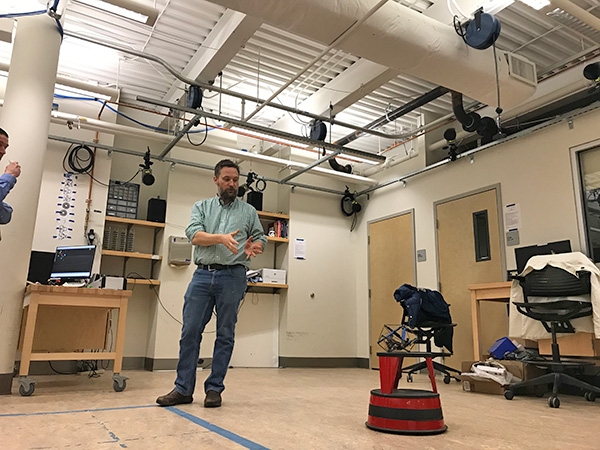As the robot made of rigid rods and cables crawled across the floor, a series of 21 high-tech cameras peering down from along the edges of the laboratory’s ceiling went to work.
Outfitted with powerful 12-megapixel sensors capable of capturing data at speeds of up to 1,000 frames per second, the cameras begin tracking a dozen points on the robot. The cameras record the position of the markers to a precision below 1mm.
The data is relayed to a nearby computer and fed back to the robot, telling the robot where it is in three-dimensional space at all times.
Welcome to a new era of interdisciplinary research at Union.
Thanks to a grant last fall from the National Science Foundation, the College recently purchased a high-speed, high precision 3D motion capture system. Similar to what’s used in Hollywood for special effects, sports teams, video game design and the military, the technology sets the school apart from many of its peers.
Housed in the CROCHET Lab (Collaborative Robotics and Computer-Human Empirical Testing) on the ground floor of Wold Atrium, the state-of-the-art system will transform the way motion capture techniques are integrated into research in fields such as biomechanics, dynamics and controls, neuroscience, biology, computer science and robotics.
“This is a differentiator for us,” said John Rieffel, associate professor of computer science and principal investigator on the grant. “Few, if any, small schools like Union has this system.”
Rieffel was joined on the grant by Jennifer Currey, associate professor of electrical, computer and biomedical engineering and co-director of bioengineering; Leo Fleishman, the William D. Williams Professor of Biological Sciences; Scott Kirkton, associate professor of biology; and Nick Webb, assistant professor of computer science. Other faculty involved include Luke Dosiek, assistant professor of electrical, computer and biomedical engineering and William Keat, professor of mechanical engineering.
Installed last month by Swedish company Qualisys, a leading provider of motion capture technology, the tool will create a new wave of broad and dynamic interdisciplinary collaborations across campus for faculty and students who study the motion of humans, insects and robots.
Rieffel was introduced to the technology a couple of years ago while working on a project in France with other researchers.
“I saw its potential and what we could do if only we had this technology,” he said. “It’s not like we could go and borrow someone’s system. They are very much in demand.”
Faculty and students are being trained on how to incorporate the technology in their research. Using a student-designed tensegrity robot fitted with reflective markers, Rieffel recently gave a short demonstration of the tool’s potential to explore the dynamical motions of soft robots.
“Now I know not only where my robot is in space at up to super high speeds, but also which direction it’s oriented,” he said as cameras tracked the robot’s movement.
The data can be used to both analyze the complex dynamics of the robot’s vibrations, as well as to control the robot in order to steer it around the room.
“It’s pretty amazing,” he said.
Other faculty already are lining up to use the technology for their research.
Leo Fleishman hopes to learn how lizards use complex motions to settle territorial disputes. Scott Kirkton wants to track the high speed jumping of locusts. Jen Currey and her students plan to examine the motion of mice to learn how they adapt to knee damage.
Rieffel expects the technology to have a profound impact on how undergraduate research is conducted at Union.
“Eventually, any student involved in plausible research will be able to come and use this space,” he said. “This system will enable us to set a new and transformative standard for the integration of motion capture techniques among STEM researchers at undergraduate institutions.”

